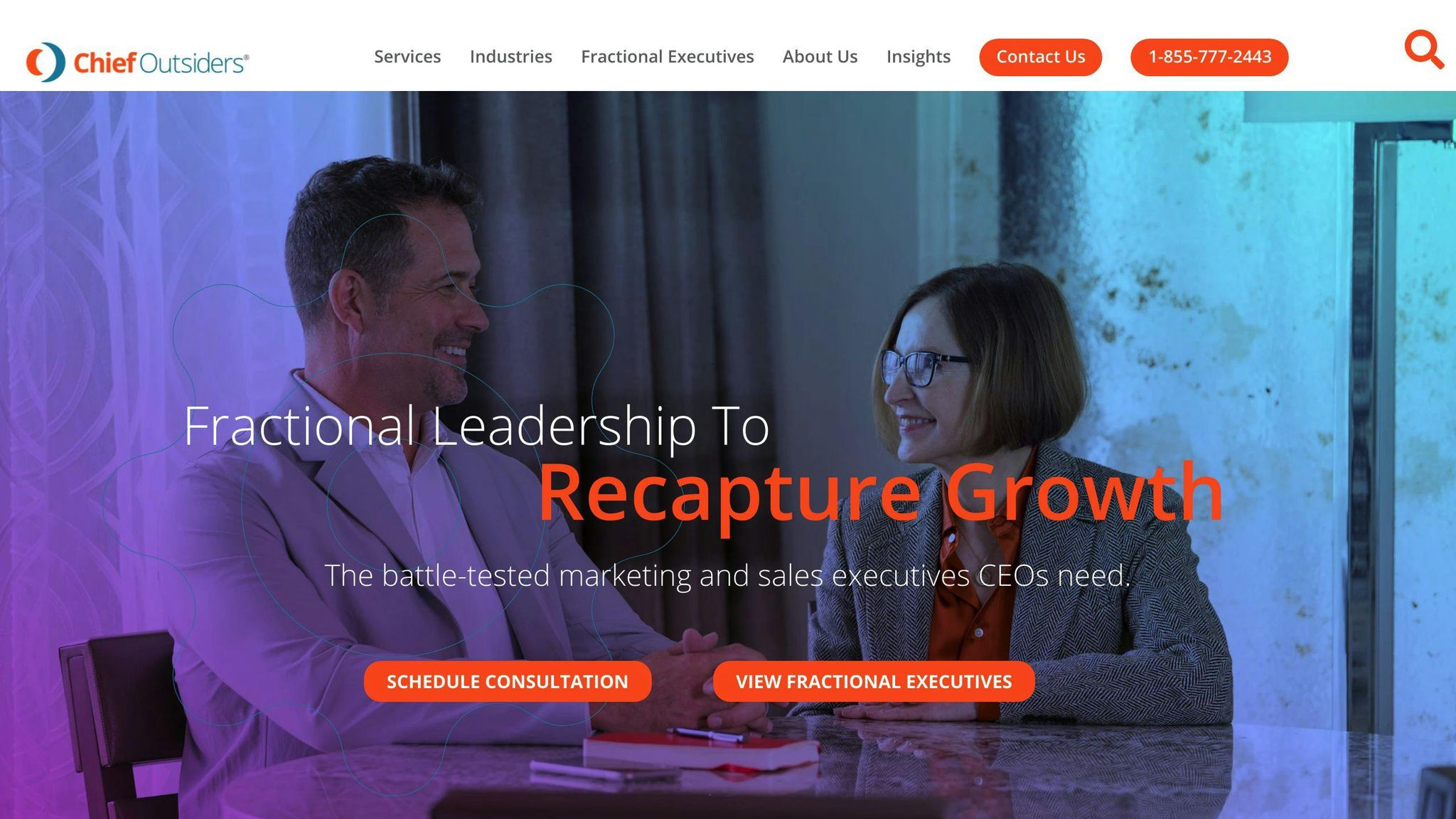Switching from a fractional (part-time) Chief Marketing Officer (CMO) to a full-time position is a significant step for growing businesses. This guide outlines when and how to make this transition smoothly, ensuring your marketing leadership aligns with your business needs.
- When to Consider a Full-Time CMO:
- Rapid business growth, such as a 25% increase in revenue or customer base
- Expansion into new markets
- A growing marketing team that exceeds 15 people
- A need for consistent leadership and strategic direction
- Pros and Cons:
- Full-time CMOs offer dedicated focus but come with higher costs.
- They can lead major initiatives more effectively but may lack the diverse experience of a fractional CMO.
- Preparing for the Transition:
- Assess financial implications and budgeting for a full-time salary and benefits.
- Ensure alignment on company goals and culture fit.
- Plan a thorough onboarding process to integrate the CMO into your team.
- Making the Transition:
- Communicate changes to your team and stakeholders.
- Ensure continuity of existing marketing strategies while allowing room for new initiatives.
- Select a candidate that not only has the right experience but also fits well with your company culture.
Remember, the decision to switch should be based on your company's growth, financial readiness, and strategic marketing needs. Proper planning and execution of the transition can enhance your business's marketing efforts and overall success.
Defining a Fractional CMO

Think of a fractional CMO as an experienced marketing boss who helps out part-time. They don't need a full-time salary because they work with different companies, usually between 10-30 hours a week for each. They can work from anywhere and might have contracts that last for a short or long time.
Core Responsibilities
What they do includes:
- Making plans based on data to help your business grow
- Helping create and share your company's message across different channels
- Improving how your ads and online presence perform
- Advising on how to present your products
- Leading your marketing team or working with outside agencies
- Keeping an eye on important numbers and results
Key Attributes
What makes fractional CMOs good at their job:
- Strategic thinking: They're good at looking at the big picture, understanding market trends, and using data to make plans.
- Marketing technology expertise: They know how to use tools for managing customer relationships (CRM), sending emails, using social media, and more.
- Flexibility & collaboration: They're great at working with different teams and fitting into various company cultures.
- Communication skills: They know how to talk to and work with everyone from top bosses to team members.
Recognizing the Right Time for Transition
Deciding to switch from a part-time Chief Marketing Officer (CMO) to a full-time one is a big step for growing businesses. When your company starts doing better, taking a closer look at how much your business has grown, what your leadership team needs, and how your marketing team is doing can help you figure out when it's time to make this change.
Growth Milestones
When your business starts doing really well, like making more money, getting more customers, or selling in new places, it might be time to have a CMO who's there all the time. Here's when to think about making the switch:
- Your money or customer count goes up by more than 25% in a year
- You're selling in more places, either in your country or around the world
- You're doing better than your main competitors
- You're starting to sell new things or kicking off big projects
Hitting these key points means you probably need more help than a part-time CMO can give.
Leadership Needs
If you're looking for a steady direction for your marketing or if you're losing marketing leaders, it might be time for a full-time CMO.
Here's when a full-time CMO can really help:
- Your part-time CMO or other marketing leaders leave
- You want a clear and consistent way to talk about your company as it grows
- Your marketing plan isn't working well across different areas, products, or channels
Bringing in a full-time CMO can help keep things steady during changes and make sure everyone's on the same page.
Team Development
If your marketing team is getting bigger, you might need someone there full-time to lead them.
Signs you're ready for a full-time CMO:
- You have more than 15 marketing people
- You're hiring for specific jobs like social media, data analysis, or writing
- It's getting hard to manage everything with just part-time help
With a bigger team, a full-time CMO can help teach your staff and make things run smoother.
In short, if your business is growing fast, you're looking for stable leadership, or your marketing team is expanding, it might be time to switch from a part-time to a full-time CMO. Keep checking how your company is doing so you'll know when it's the right time to make this important move.
Pros and Cons of Making the Transition
Switching from a part-time Chief Marketing Officer (CMO) to a full-time one has its good and bad sides. Let's look at them.
| Good Points | Bad Points |
|---|---|
| They're all yours, no sharing | Costs more money |
| Really gets your company | May get stuck in one way of thinking |
| Can fully lead big plans | Harder to judge their work |
| Better teamwork and happier staff | Can cause issues if not done right |
| Clear boss for decisions |
Good Points
When you make your part-time CMO a full-time employee, they can give your business all their focus. This means they're not juggling your company with others, so they can dive deep into what makes your business tick.
Being around all the time, they'll know the ins and outs of your company, helping them make plans that really fit. They can also stick with a project from start to finish, making sure everything runs smoothly.
Having one person in charge of marketing makes things clearer for everyone. It helps your team work better together and makes people happier at work.
Bad Points
However, having a full-time CMO costs a lot more. You're not just paying for their time; you're covering their full salary, benefits, and more. This can be tough for smaller businesses.
A full-time CMO might also miss out on fresh ideas from working with different companies. This could make them less creative compared to someone who sees a variety of marketing strategies.
If your business changes a lot, a full-time CMO might not be as flexible as a part-time one. It can also be hard to tell how well they're doing when they're part of the team.
And if you don't manage the change well, it can lead to confusion and problems in your company. It's important to move carefully and keep everyone informed.
In the end, whether you should make your CMO a full-time hire depends on where your business is at, how much you can spend, and how much flexibility you need. Think it through and choose what's best for your situation.
Getting Ready for the Big Move
Switching from a part-time to a full-time Chief Marketing Officer (CMO) needs careful planning. You have to think about money, making sure everyone's goals line up, and whether the new CMO will gel with your team's vibe. Planning ahead makes the change smoother and sets you up for success.
Thinking About Money
When setting up your budget, you should consider:
- How much a full-time CMO expects to get paid, including their salary, bonuses, shares in the company, and health benefits. Look up what's normal for your industry and area.
- Costs of looking for someone if you're hiring from outside.
- How much more you'll need for your marketing budget in the next few years to support the CMO's plans.
- Any costs to end the contract with your part-time CMO.
Make sure hiring a full-time CMO fits with your financial plans and what you can afford right now.
Making Sure Everyone Agrees
Make your business goals clear to the CMO. Show them what's happening with sales, what products you're planning, and what the top team expects.
- Talk about what you hope the CMO will achieve and how marketing fits into the big picture.
- Plan out the big dreams the CMO can help make real.
- Get everyone on the top team on board with bringing in a full-time CMO.
This helps avoid confusion or goals that don't match up, which can slow things down.
Checking the Team Vibe
Make sure the new CMO will fit in well with your team and the way you do things.
- See if the CMO's values and how they work match up with your company.
- Look at how ready your company is to try new marketing ideas.
- Plan how to welcome the CMO, help them get to know everyone, and start off on the right foot.
Making the CMO feel part of the team helps avoid them feeling left out, upset, or leaving quickly. Your company needs to be ready for a full-time marketing leader for it to work.
Putting time into planning your budget, making sure goals are aligned, and making the CMO feel welcome will help you smoothly move from a part-time to a full-time CMO. Treat this like any big change in your business. Working together early on makes it easier to handle any bumps along the way.
sbb-itb-5c5ac24
Making the Transition
Communication Plan
When you're moving from a part-time to a full-time Chief Marketing Officer (CMO), it's really important to let everyone know what's happening. Here's how you can do it:
- Tell everyone about the new CMO using emails or at a big meeting. Talk about their experience and how they'll help the company grow.
- First, have the CMO meet the marketing team to discuss plans. Then, introduce them to other team leaders to work on shared goals.
- Explain what the CMO will do in simple terms through emails or on the company website. Make sure people understand how this role is different from the part-time CMO.
- Make it easy for people to talk to the CMO. Encourage everyone to share their thoughts and ideas with them.
Onboarding Process
To help the new CMO start off right, you need a good plan:
- Give them access to important tools like CRM, email, and data systems right away.
- Set up meetings with top leaders during their first week to talk about the company's goals and what's already happening in marketing.
- Set clear goals for the first 30, 60, and 90 days. This includes getting to know the team, understanding current marketing efforts, and coming up with new ideas.
- Introduce them to your business partners so they can understand how they work and keep those relationships strong.
Ensuring Continuity
Keeping things running smoothly during the change from a part-time to a full-time CMO is crucial:
- Keep up with what's already working. Use the good stuff from before while adding new ideas.
- Use what's already there like brand messages, customer profiles, and summaries of past campaigns to help the new CMO catch up fast.
- Work with the part-time CMO for a month or two to share their knowledge before they leave.
- Make it clear who decides on changes to marketing plans and how money is spent right from the start.
Selecting the Right Full-Time CMO
When you're thinking about moving from a part-time to a full-time Chief Marketing Officer (CMO), it's really important to pick the right person. This means you need to know exactly what you're looking for, check out their past work carefully, and make sure they'll fit in well with your team.
Defining Needs
- List what you want to achieve with your marketing, like getting more customers or entering new markets.
- Write down the skills your CMO needs to have, such as planning, analyzing data, running campaigns, and leading a team.
- Mention any specific technology or tools they should know how to use.
- Point out if you need them to have special skills for certain projects you have in mind.
- Talk about the kind of leader you're looking for, someone who matches your company's values and way of doing things.
Being clear about what you need helps you find a CMO who can really help your business.
Assessing Experience
- Look at where they've worked before and what they did there. You want someone who's been in charge of marketing and done well.
- Ask for examples of their work that show they know how to get good results.
- Make sure they have experience with different kinds of businesses and can adapt their strategies.
- It's a plus if they're also good at hands-on tasks like writing or making ads.
- Check if they have experience with different ways to grow a business, from improving your brand to getting more sales.
Checking their background makes sure they can handle the job.
Cultural Fit Evaluation
- During interviews, see if their leadership style and personality are a good match for your company.
- Talk about how they like to work, whether they prefer being independent or working closely with others.
- Find out if they're creative and open to new ideas but also practical.
- Make sure they're good at teaching and growing a marketing team.
- Check if they're okay with changes and challenges as your company grows.
Making sure they'll fit in with your team means they'll be more likely to stick around and do well.
By taking these steps, you'll be more likely to find a part-time CMO who can successfully switch to being a full-time member of your team, making a big positive impact on your business.
Conclusion
Switching from a part-time to a full-time Chief Marketing Officer (CMO) is a big step. Here's what you need to remember:
Know when it's time to switch
- Look at how much your business has grown, if you need more leadership, and if your marketing team is getting bigger to see if you're ready for a full-time CMO.
- Think about the good and bad sides. A full-time CMO can give all their attention to your company, but they also cost more and might not be as flexible.
Get ready properly
- Figure out how much you'll need to pay for things like salary and benefits, and think about the costs of finding someone new if you're hiring.
- Make sure the goals of your company match up with what the new CMO wants to do. Everyone needs to agree on the plan.
- It's important that the CMO fits well with your company's culture. They should work well with your team and understand your company's values.
Make the change smoothly
- Tell your team about the new CMO and explain what they'll be doing differently from the part-time CMO.
- Help the new CMO get started by giving them access to important tools and information, setting up meetings with leaders, and giving them clear goals for the first few months.
- Keep things running well by using what's already working in your marketing and working closely with the outgoing part-time CMO.
- When picking a new full-time CMO, make sure they have the right skills, experience, and they're a good fit for your team.
Making the move from a fractional to a full-time CMO can help your business grow if you do it at the right time, get ready in the right way, and handle the change carefully. Think about what your business needs, plan well, and work together with everyone involved to make sure the transition goes smoothly.
Related Questions
What is the average rate for a fractional CMO?
Usually, a part-time Chief Marketing Officer (CMO) charges about $150-300 for each hour they work. This can change based on how much experience they have and the kind of help they offer. Some prefer a monthly payment for a set amount of work time.
What is the average hourly rate for a fractional CMO?
A part-time CMO's hourly rate often falls between $150-375. This varies with their level of experience, the area they specialize in, and the services they provide. They might bill you by the hour or ask for a fixed monthly fee for a certain number of hours.
What should a CMO do in the first 90 days?
In the first three months, a new CMO should:
- Learn about the company's team, how things are done, and what's important
- Review the current marketing plan and how it's doing
- Find some quick, positive changes to make a good impression
- Start planning for the future
- Build good relationships with important people both inside and outside the company
- Make clear marketing goals, how to measure success, who does what, and how things work
- Make sure the sales and marketing teams are working well together
When should I hire a fractional CMO?
You might want a part-time CMO if:
- You need someone to lead your marketing but can't pay for a full-time CMO
- You're looking for expert advice on certain marketing projects rather than everyday tasks
- You want a fresh, professional perspective on your marketing strategy
- Your marketing team lacks specific skills like digital marketing, branding, or using data
- Your business is growing fast and you need to quickly improve your marketing
A part-time CMO is a flexible, cost-effective way to add marketing expertise or fill a leadership gap temporarily.



